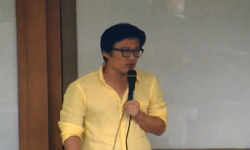(Background and Purpose) Since the establishment of the museum law in 1984, the number of museums in South Korea has grown rapidly due to the policy of museum cultural facilities and the continued interest of local governments. According to one analys...
http://chineseinput.net/에서 pinyin(병음)방식으로 중국어를 변환할 수 있습니다.
변환된 중국어를 복사하여 사용하시면 됩니다.
- 中文 을 입력하시려면 zhongwen을 입력하시고 space를누르시면됩니다.
- 北京 을 입력하시려면 beijing을 입력하시고 space를 누르시면 됩니다.

자연계 박물관의 전시체계 및 내러티브 구조 분석에 관한연구-국내사례를 중심으로- = A Study on the Analysis of Exhibition System and Narrative Structure in Natural Museums - Drawing on the Domestic Cases -
한글로보기https://www.riss.kr/link?id=A106019875
- 저자
- 발행기관
- 학술지명
- 권호사항
-
발행연도
2018
-
작성언어
-
-
주제어
Natural museum ; exhibition space ; narrative ; exhibition system ; plot ; 자연계 박물관 ; 전시공간 ; 내러티브 구조 ; 전시체계 ; 플롯
-
KDC
600
-
등재정보
KCI등재
-
자료형태
학술저널
- 발행기관 URL
-
수록면
263-273(11쪽)
- DOI식별코드
- 제공처
-
0
상세조회 -
0
다운로드
부가정보
다국어 초록 (Multilingual Abstract)
(Background and Purpose) Since the establishment of the museum law in 1984, the number of museums in South Korea has grown rapidly due to the policy of museum cultural facilities and the continued interest of local governments. According to one analysis, the number of museums in 2007 was 360, which grew to more than 860 in 2018; and the number of museums in 2005 has increased by about 500 in 10 years. In this way, museums have continued to increase in quantity, and a social problem is emerging: many have not yet been utilized as cultural facilities. Thus, the purpose of this study is to analyze the exhibition structure and space for qualitative development by effective exhibition education that is appropriate for the quantitative increase of museums in South Korea. (Method) This study analyzed the narrative structure of the exhibition space and the problem of the exhibition system by selecting the museum of professional nature operated in South Korea. In addition, this paper has analyzed in detail the structure of the narrative and the exhibition system as a solution to the analyzed problems and presented the results. Visitations of professional museums of natural history in South Korea have been conducted in this study, as have interviews with curators and an analysis of literature, annuals, and web surveys. (Results) The results of this study are as follows. First, the narrative form of the professional museums of natural history in South Korea is structured from the concept of symbolism derived from the process of transferring meaning generated by each museum's exhibition system and its shape. Second, it the formal classification system is composed of the independent picaresque plot format. Therefore, it is expected that the effect of education will be further enhanced if the acceptable information and exhibition system are provided for visitors and users. (Conclusions) The purposes of this study is to propose a display structure that allows visitors and users to understand the purpose and information of the museums by analyzing cases of professional museums of natural history in South Korea and identifying relevant problems. The data from this research shows that information can be transmitted to visitors and users more effectively by using a narrative structure.
동일학술지(권/호) 다른 논문
-
- 한국공간디자인학회
- 김자영
- 2018
- KCI등재
-
유휴산업시설을 활용한 복합문화공간의 공간적 특성에 관한 연구
- 한국공간디자인학회
- 박수린
- 2018
- KCI등재
-
장애물 없는 생활환경인증 현황조사 및 분석에 관한 연구
- 한국공간디자인학회
- 임오연
- 2018
- KCI등재
-
- 한국공간디자인학회
- 이성숙
- 2018
- KCI등재




 KCI
KCI KISS
KISS




